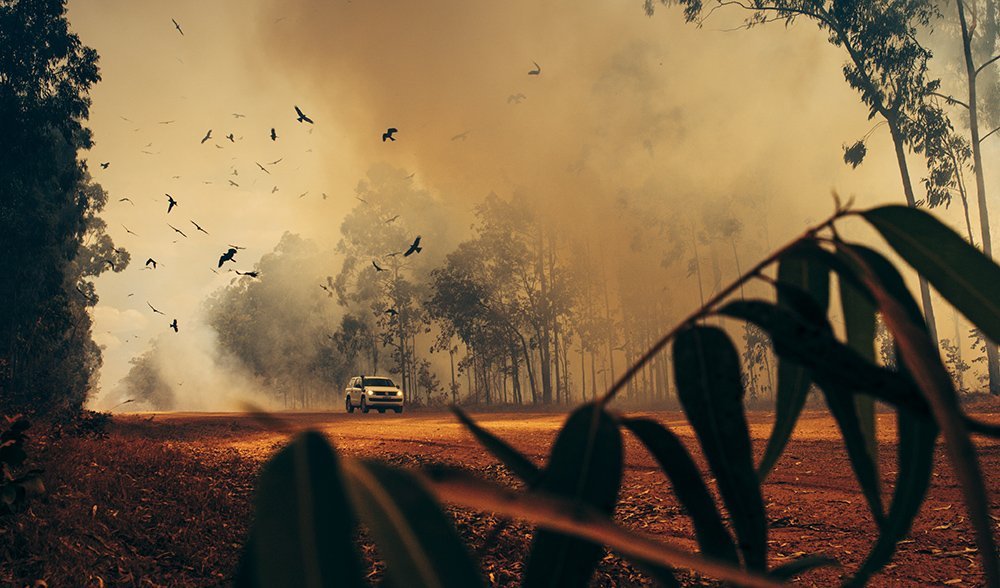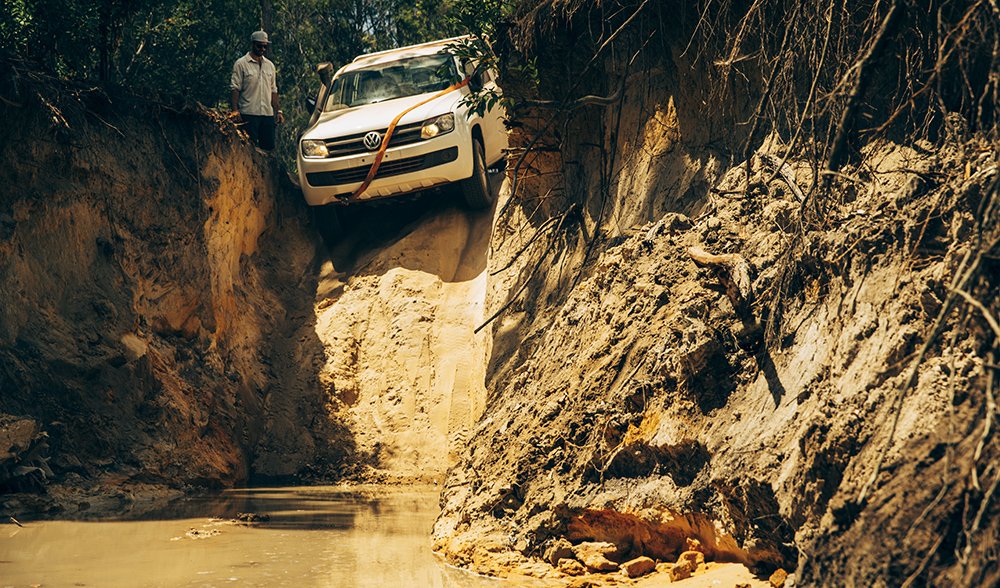Road trip: Cape York, QLD

REACHING THE NORTHERNMOST point on the Australian continent in a 4WD has become the stuff of off-road legend, whispered about over campfires, laughed about over painful-to-watch ‘Fail’ videos on youtube. Smashed, drowned and ruined vehicles litter the annals of Cape history, to say nothing of the countless bruised egos and emptied wallets. Words such as “Gunshot” and “Nolan’s” are thrown around in bush banter as distinct badges of honour if you’ve tackled them… and near-misses if you haven’t.
Long the exclusive domain of hardcore off-road enthusiasts and aftermarket-equipped 4WDs, a trip to The Tip can seem rather daunting. That notion became even more intimidating when VW invited AGA to drive the torturous route in Amaroks. Standard Amaroks. (Well, mostly. Our six-strong convoy was fitted with aftermarket snorkels from German aftermarket supplier Seikel.)
The aim of the drive was to throw Amarok’s Core Edition models, the company’s tilt at entry-level ute supremacy, at some of the toughest terrain Australia has to offer and see how the vehicles fared.
Three days, 13 blokes, six Amaroks and more than 400km of corrugations, 4WD-swallowing ruts and windscreen-deep water crossings. Was this a fast blast to disaster or delight?

A controlled burn scatters wildlife, predator and prey, outside of Weipa.
The fire (day 1)
It was mid-August, The Dry in this part of Australia; that’s winter for the rest of us. The Dry, between June and October, is the best time to visit Cape York Peninsula, according to Queensland’s Department of National Parks, Sport and Racing. The Wet (November to April) is too wet, and many tracks up this way become impassable, or at the very least, troublesome, and there are wet season closures from December to June, July or August “depending upon weather and road conditions”.
Our convoy – with VW staffers in the top and tail vehicles – swept out of Weipa, as slick as a Route Irish military convoy in war-time Iraq. We were heading east for our day’s-end destination of Moreton Telegraph Station, about 133km away.
We powered along over smooth dirt roads and stretches of bitumen at a fair clip when, seemingly only minutes later, our trip was over before it had even begun. The convoy was stopping, coming to an abrupt halt at the side of the track that stretched away into the distance. There was what looked like a controlled burn just outside of Weipa, so we all got out of our vehicles to watch expert snapper Chris Benny as he busied himself capturing the spectacle.
Acrid smoke tickled our nostrils. The heat from the flames was intense. Hundreds of lizards and myriad other wildlife species fled from the bushland on one side of the road, which was alight, to the relative safety of the other side, which wasn’t. We stutter-stepped around scattering wildlife, mindful of the threat of snakes. Birds were busy dive-bombing the scurrying creatures below, gorging themselves on the spoils of this mass exodus. It was a wild sight; indicative of what was to come in this largely untamed wilderness.
With shots in the bag, and no bites from freaked-out fauna, we drove off and turned left onto the legendary Old Telegraph Track on our way to Moreton Telegraph Station.
As we neared Moreton Telegraph Station, bathed in late-afternoon sunlight, we saw the first of many “Beware! Achtung! Crocodiles!” signs in this part of the country. It was a not-so-gentle reminder that in Cape York, this last frontier of real adventure, man is not necessarily top of the food chain. I kept this in mind as I gingerly tested the creek waters near our camp with my boot.

The exquisite Eliot Falls.
The gunshot (day 2)
Up with the sun the next day, our Core convoy was scheduled to drive 129km from Moreton Telegraph Station via Bramwell Junction to Eliot/Twin Falls.
At Bramwell Junction Roadhouse, our group was met with derision by a few of our fellow Tipsters.
One lady was so besotted with her own joke that she repeated it along the entire convoy, from our tail-end Charlie all the way to the lead vehicle, cackling as she went.
“Anoraks,” she chortled. “The Anoraks are here.”
“Where you goin’?” she asked me.
“The Tip,” I replied, knowing she was setting me up for a knock-out joke.
“Well, you got this far at least!” she screeched and off she trotted – to her LandCruiser or something else similarly hardcore suited and booted.
With her taunts ringing in our ears, we continued on the OTT proper.
Termite mounds, some 3m tall, had stood sentinel on either side of the track for much of the way. The air was dry and dusty and warm, but not uncomfortably so; that didn’t matter though because we were about to get our feet wet.
The first few creek crossings were easy enough and made for handy lead-ups to what was to come. Smooth progress was simple once the rear diff was locked and off-road mode was selected. The rest was up to the driver: wisely pick your way down the approach, maintain steady momentum through the water, and then up and out the other side. Easy. No need to gun your way through; just steady use of throttle, backed up by the Amarok’s more than capable tech.
These VW’s have a 500mm wading depth and we were deeper than that pretty much from the start, so it was a good thing we had the snorkels.
Nick Reid, at the previous day’s briefing, had said that the Amarok Core was “better experienced than explained” – and we were about to definitely experience it. The next creek crossing, a seriously tight, twisty switchback affair caught out a few drivers; scraped front bumpers and banged-up trays were the result, but that was about it.
The auto’s low-low first gear, in lieu of a low-range transfer case, and the Amarok’s unflinching hill descent control – it holds your desired speed downhill – proved an unbeatable off-road combination on the tougher sections of this track.
The standard rear diff-lock and front-wheel traction control helped get the Amaroks over most other obstacles, including the very steep and greasy muddy uphills we were often faced with.
After working our way through numerous creek crossings, we suddenly faced The Big Daddy of All 4WD Challenges: the Gunshot. There are, in fact, numerous ways through Gunshot, most of them near-vertical extreme, but we found our planned route and one of the support Amaroks gave it a good crack.
But, minutes later, standing alongside one of the notorious Gunshot Creek’s many gnarly tracks, we were all gutted.
One of our number – Director of VW Commercial Vehicles Australia, Carlos Santos, in a cab-chassis support vehicle – had just tackled a severely steep drop-off into a greasy, waist-deep pool of mud. And he was now stuck. The degree of extreme could have been gauged by the scared/stunned/thrilled look on Carlos’s face. And he’d almost made it. But now the tray’s rear was well and truly hooked on a rocky outcropping. He was going nowhere under his own steam. Thankfully, a fellow Tipster in a Patrol ‘snatched’ our stranded companion out of his predicament.
But a decision had to be made: should we try to get the rest of the crew through and risk sustaining serious damage to every vehicle and putting us way behind schedule, or swallow our pride and back-track for the bypass road?
Karl Gehling, VW Australia general communications manager, made the executive decision. We would abandon any attempt at getting through Gunshot. There was a collective groan from all of us. This was what we had come for: the nail-biting drop, the muddy plunge, the thrill of the nigh-on impossible obstacle.
I reckon we could have gotten through, albeit with a bit of winching, scraping and shoving. There would have been damage; most of it substantial, none of it justifiable.
There and then, in that moment, Karl had made the right decision.
We back-tracked more than 20km onto the bypass road and continued on.
Later, at our Eliot Falls campsite, we jumped off towering rock faces, and ducked and dived under the cool water of the waterfalls there. As Chris Benny’s drone swooped and swooshed over and around us, we let our inner schoolboys rule and whooped and dive-bombed into the cool water below.

Taking on Gunshot.
The Tip (day 3)
The final day was a 167km run from our camp to The Tip.
We whizzed through several creek crossings, with ominous sounding names such as Mistake and Cannibal, scattered along the 40km route to the Jardine River. We were excited at the prospect of taking on Nolan’s Brook, the last great challenge of this trip, so those other crossings barely registered as we punched our way through them.
Nolan’s Brook is right up there with Gunshot as a 4WD-killing, hopes-dashing, pride-smashing off-road obstacle; many have tried, a lot have failed.
As we pulled into the area around Nolan’s, one bloke there advised us that he’d heard that sending three vehicles – and only three – at a time was the way to go, otherwise the creek’s base would be so churned up, it would be almost impossible to get across.
There were more than two ways across but, turns out, we needn’t have worried. Having picked a careful line, we eased into the water gently, took a sharp right turn to avoid a deep hole or two, and kept a steady pace across the creek. That was the way to go. Only a couple of us had to be snatched out.
We watched as a three-vehicle convoy behind us carefully scoped out the crossing, decided on a plan, drove it and moved on.
Having conquered Nolan’s, we had lunch on its banks, savouring the peace and quiet and throwing around congratulatory back-slaps.
From there, it was a solid thrash over corrugations, with our utes settling better on the rough stuff than you’d ever expect of an unladen ute, to the Jardine River ferry.
North of the Jardine River, we raced over the well-maintained dirt roads at a healthy clip to Bamaga, parked as near to the northern edge of Australia as legally possible and then took a short walk across a rocky point to The Tip for the obligatory series of photos.
That night at Punsand Bay’s Corrugation Bar, smiles were wide, beer was cold and tall tales were told. We all agreed that The Tip was tops.

You’ll always remember your first trip to The Tip.
The essentials
Getting there: It’s about a 430km trip from Weipa to The Tip. This trip is best suited to experienced four-wheel drivers in, you guessed it, four-wheel drives.
Best time to go: The Dry, between June and October, is the best time to visit Cape York Peninsula. The Wet (November to April) is too wet, and a stack of tracks may be impassable and/or closed by Queensland’s Department of National Parks, Sport and Racing.
The adventure: Use your own 4WD or hire one from several operators in FNQ. Make sure your 4WD is in tip-top mechanical shape before you go anywhere. Take spares of everything and plenty of food and water.
Accommodation: Numerous campsites along the way as well as cabin-style accommodation at various locations. Visit www.tourismcapeyork.com and www.nprsr.qld.gov.au.
READ MORE:
- Australia’s best 4WD tracks
- Steve Irwin’s legacy lives on in Cape York
- Destination: Tropical North Queensland

